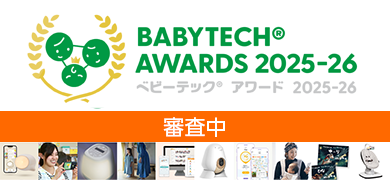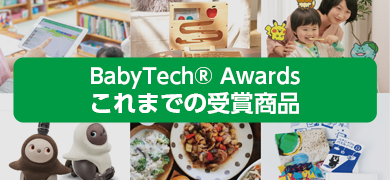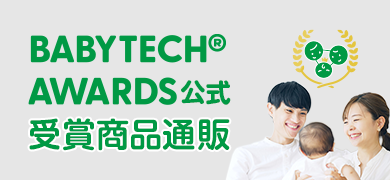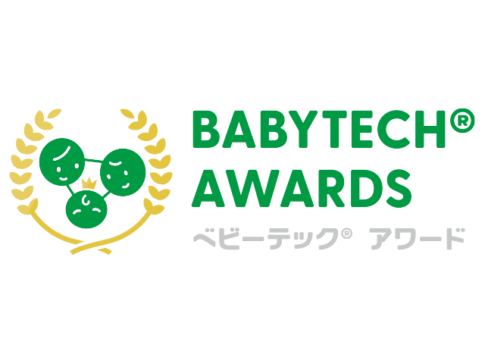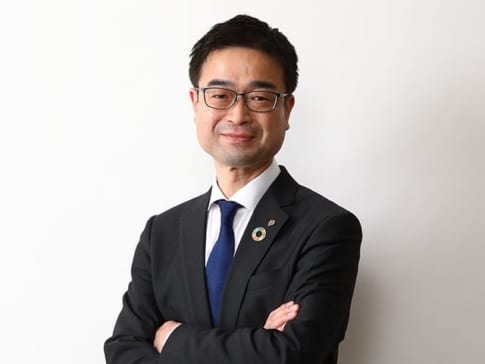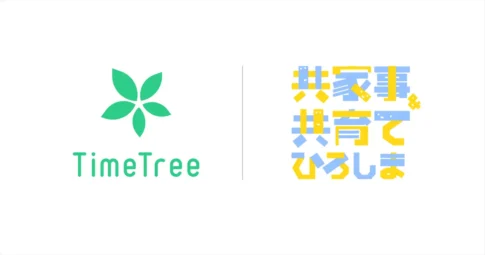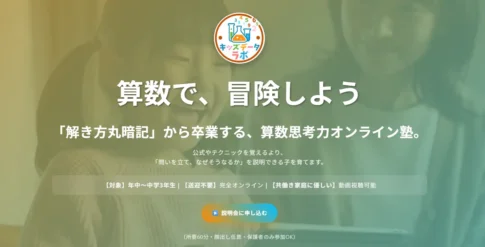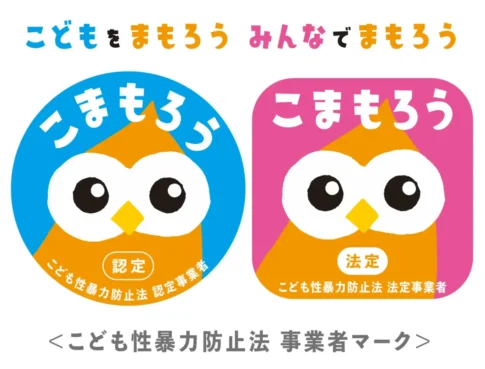- All materials are completed on a single tablet. No storage space is required, and learning can begin immediately.
- The program has many features that enable young children to learn by themselves, such as "voice reading" and "automatic grading.
- Learning content is stored in the cloud, which is then used to enhance teaching materials.
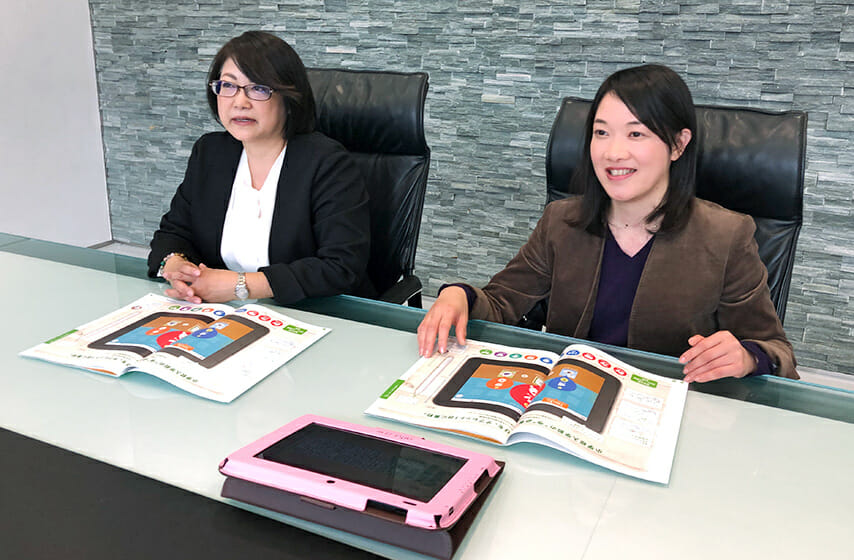
Mr. Terao is on the left. Mr. Kamata is on the right.
(We spoke to...)
Just System Inc.
Learning Innovation Division
Senior Expert, Planning and Marketing Group
Fusayo Terao
Just System Inc.
Learning Innovation Division
Expert, Planning and Teaching Materials Group
Miyo Kamata
All the teaching materials necessary for children's "independent learning" are integrated into the tablet!
Editorial:Can you give us an overview of the Smile Zemi Preschool Course?
Terao:The first feature is that "learning materials can be learned only on a tablet. This is a big difference from other companies' preschool materials, which use multiple booklets and printouts. We have set 10 areas (Hiragana, Katakana, Words, Numbers, Shapes, Clocks, English, Pictures, Life, and Nature) as the content for children to learn in their early childhood, and we have structured the materials so that they can learn all of them every month.
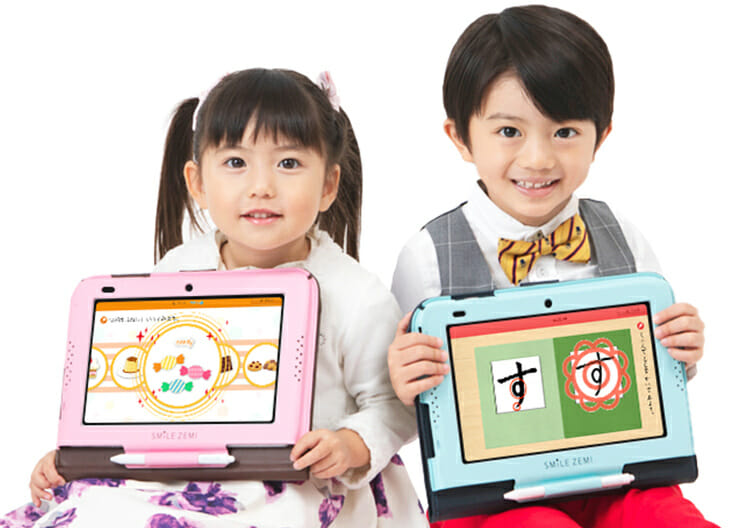
This tablet completes everything.
Kamata:When the tablet is activated, the material to be worked on that day is presented as "Today's Mission," and by following it, children are able to learn 10 areas every month without bias. In addition, grading (checking correct and incorrect answers) is done automatically, and even if a mistake is made, the system does not give a cross, but encourages the child to try again, saying, "Let's think about it one more time. When the day's tasks are completed, the results are summarized in a single screen called "Today's result! The results are summarized on a single screen called "Today's result! Parents can then place a flower circle or stamp on the page, allowing parents and children to look back on the day's results together. Today's Accomplishments! is also a record of your child's growth.
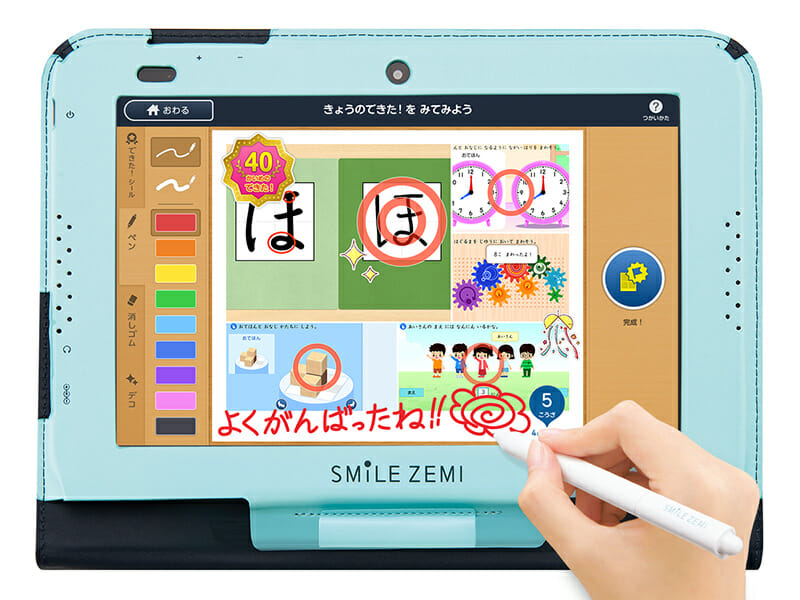
The day's study content is summarized on a single screen, allowing parents and children to check it together.
Editorial:For general materials, I would work on the booklets and printouts that are sent monthly, which are then graded by the parents.
Kamata:Since it is quite a burden for parents to look at all the questions and mark them as well as ......, we believe that having the grading done automatically and being able to view the results in a consolidated manner is a great advantage. Furthermore, "Today's Done! can be viewed on a smartphone, so for example, you can share the results with your mom or dad, who comes home late from work, and say, "This is what you studied today. ......
Editorial:This is a feature unique to digitized teaching materials!
Kamata:Smile Zemi Preschool Course also has a recording and playback menu, so you can check your child's English pronunciation later. In addition, there is a function that allows you to check the order in which your child writes letters by replaying the video afterwards.
Editorial:That is very interesting! You can never do that with paper materials. In fact, you don't have to worry about your child making a mess like with paper materials, and you don't have to worry about finding the next material to do. And you don't have to worry about where to store the materials. ...... I thought it was wonderful.
It is a great way to practice writing just like on paper," he says.
Editorial:From what age can I use the "Smile Zemi Infant Course"?
Terao:The course is designed for kindergarten and nursery school children from the winter time to the older children. Basically, we have devised a structure that allows the child to learn alone, without the presence of mom or dad, and allows parents and children to see the results together at the end of the course.
Editorial:So parents can do other things while their children are studying.
Terao:For example, while preparing a meal, you can quickly take out your tablet and get started.
Kamata:We have been very particular about the fact that "basically, you can study by yourself. For example, all of the materials have a "voice reading out loud" function. This is so that even children who cannot read can understand the content. When explaining problems involving figures, etc., the app uses not only text and voice, but also animation to show movement and make it easier to understand. Many of the educational apps for young children in the world are simply touch-based, but "Smile Zemi: Infant Course" also features the ability to write with a pen and move items on the screen with a finger.
Terao:Recently, there has been a strong demand from parents who want their children to be able to read and write hiragana and katakana by the time they enter elementary school. The "Smile Zemi Preschool Course" uses a special tablet and pen so that students can practice writing with the same sensation as writing on paper.
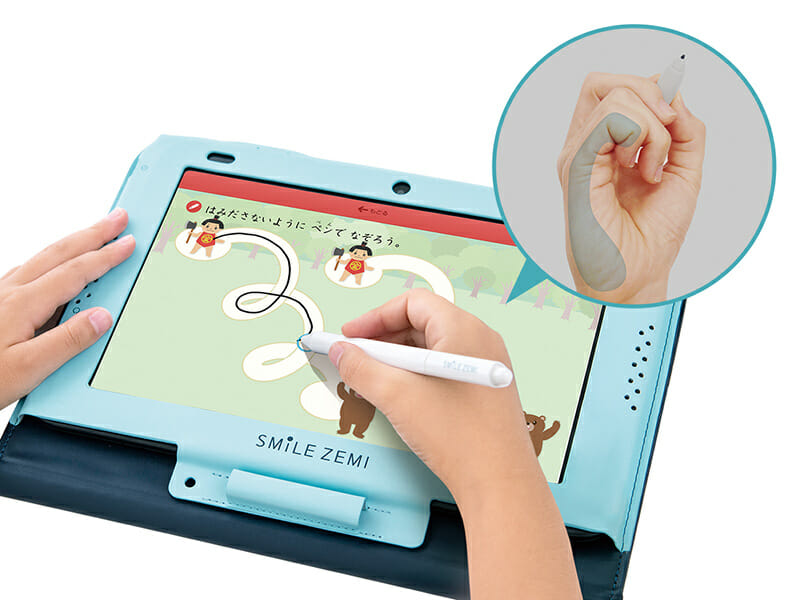
Can practice writing with part of the hand touching the tablet
Editorial: On a regular smartphone or tablet, when you hold the pen, if part of your hand touches it, it will recognize it on its own and behave strangely.
Kamata:Yes, we do. The pen is specially designed to be triangular and easy to hold, and for children who are writing for the first time, the teaching materials use "voice" and "animation" to guide them through the writing process.
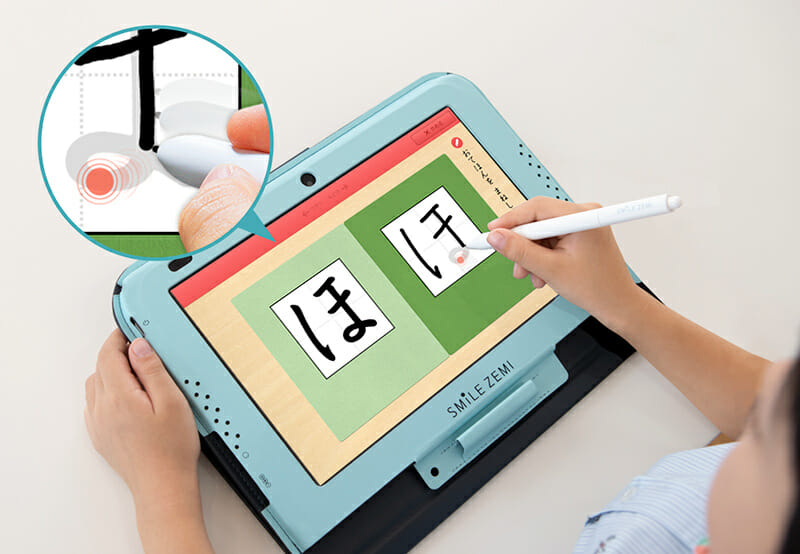
A red marker moves and you can follow it to write letters in the correct stroke order.
Editorial:This will be taught better than ...... parents.
Kamata:It also has the ability to point out what is wrong with the characters you have written. For example, in the case of hiragana, it tells the child, "This part is popping out, so let's try to write it so it doesn't pop out," thereby encouraging the child to work on it again spontaneously. When a parent points out a mistake, the child may inevitably become more depressed than necessary or rebel, but a third-party tablet has the advantage of making it easier for the child to accept.
Editorial:When children make too many mistakes, parents tend to get emotional, but with a tablet, no matter how many times they make a mistake, they will calmly tell you (laughs).
Over 20 years of commitment to elementary and secondary school education
Editorial:I have an image of your company as "the Ichitaro and ATOK company," but how did you get involved in this kind of early childhood education?
Terao:Since 1999, we have been developing and selling software called "Just Smile" for use in elementary schools, and have had the opportunity to communicate with many teachers. In the early 2010s, the "Courses of Study" were revised and the number of subjects increased significantly, but the amount of class time did not increase that much, so teachers increasingly told us that they could not teach all the content in school education alone. ...... The teachers told us that they could not teach all of the content in school education alone.
Editorial:It is the end of the so-called "Yutori Education". I have heard that in recent elementary schools, "hiragana" and "numbers" are no longer taught carefully, and classes proceed as if students know them almost from the beginning.
Terao:That's right. In response to many teachers who said, "From now on, it is important to develop basic academic skills through home study," we began development of a learning program by utilizing our expertise in software development for elementary school students. This is the "Smile Zemi: Elementary School Course," which we began offering in December 2012. In 2013, we began offering the "Smile Zemi Junior High School Course.
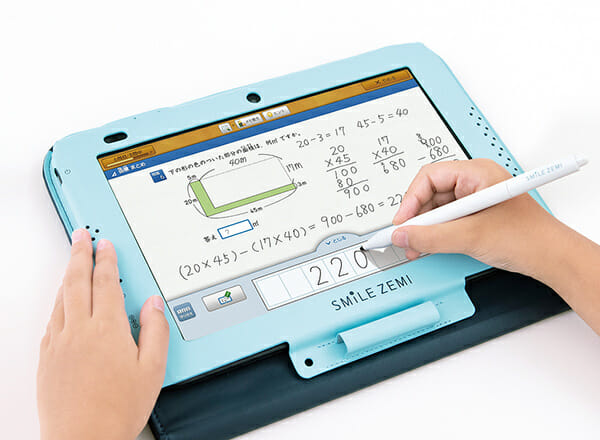
Smile Zemi Elementary School Course

Smile Seminar Junior High School Course
Terao:As the number of children studying at Smile Zemi increased, their younger siblings started saying, "They want to do it, too! We have received many comments from parents asking if there is a course for infants, so we started the "Smile Zemi Infant Course" in December 2018.
Creating detailed teaching materials that meet the needs of children's growth.
Editorial:I could understand that your company had a backbone connected to early childhood education. Did you have any difficulties in developing the product?
Kamata:We conducted a number of user tests prior to release and found that we needed to take into consideration the unique considerations of young children with regard to user interface design. For example, "They don't notice the button to go to the next screen. For this reason, we reviewed the "flow line" in the learning process, for example, by displaying large guidance marks. Instead of displaying multiple guidance marks at the same time, the next guidance mark is displayed after one operation is completed. We realized that it is very important to have the children try out the operation and carefully check how they will try to operate the device.
Editorial:Little children manipulate what they see, don't they (laughs)?
Kamata:In the hiragana practice, I thought it would be easier to write larger letters, so I made the squares larger, but I found that infants have small hands and it was hard for them to write, so I adjusted the size of the squares.
Terao:In the case of young children, what is possible for older kindergarteners may be difficult for younger ones, and there is a large difference depending on the "birth month," so we asked a group of children of different ages as well as different birth months to come together for testing prior to release.
Editorial:During user testing, were there any requests from parents?
Kamata:We have added various patterns to the "direction when you solve a problem and get a correct answer" because we want to see more and more of them included. I added a variety of patterns. We also encourage children to praise their teachers and teachers' staffs. The children like the flower circles, the glittering effects, and the fun animations.
Highly rated for "encouraging independent learning" and quick enhancements unique to digital
Editorial:What kind of feedback have you received from users?
Kamata:We regularly conduct user surveys, and the most common comment is that "it is good to be able to study alone. Also, the "automatic grading function" is popular among parents. Many say that since the materials are only on the tablet, it is easy to clean up. Some parents say that since it is the first experience for their children to hear their own voice recorded, they like the fact that they can learn by recording their own voice, and that they can enjoy working on their own.
Editorial:What do you mean by "nature" and "life"?
Kamata:The "Life" section is about annual events and manners. Nature" is about plants, animals, and natural phenomena, and is illustrated with photos and videos.
Editorial:Thank you very much. Finally, please tell us about future developments and updates.
Kamata:We are constantly receiving feedback and delivering updates to strengthen the program. For example, when we received a comment that the correct and incorrect answers in the Hiragana practice were judged too strictly, we analyzed the actual learning data and made various enhancements. Specifically, we first examined the learning history and stroke data (handwriting) of all children using the Smile Zemi Preschool Course. Where the judgments of correct or incorrect answers were too strict, we made readjustments for each letter. Such adjustments are also made for other courses.
Editorial:It is because of the digital materials that we are able to analyze the children's learning in such detail!
Kamata:All quantitative data is analyzed, and qualitative content is reflected in the Smile Seminars more and more through regular surveys.
Terao:In the case of paper, the cycle is that students study throughout the year and then go to ...... to see if the materials are revised the following year, but the advantage of digital materials is that they can be updated as needed. Another development from a longer-term perspective is to strengthen our response to the "compulsory English language instruction at elementary schools. At this stage, I think elementary school teachers are still groping their way through the process, but we would like to incorporate the content necessary for early childhood education based on the Courses of Study and other guidelines.
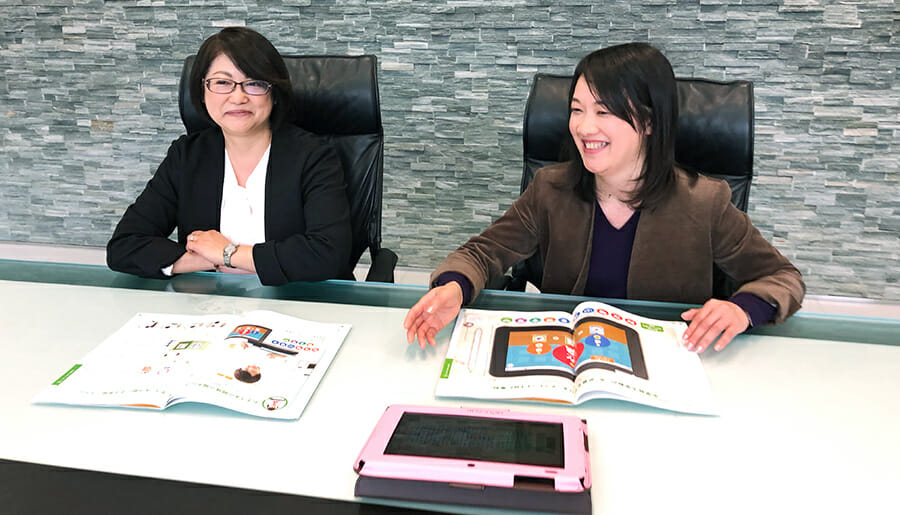
Mr. Terao and Ms. Kamada talk about the future of the "Smile Seminar Infant Course.
<After the interview
We felt that this service is very suitable for working families who are busy on a daily basis and would like to try some kind of early childhood education at home (......). The room tends to be cluttered during child-rearing, so having a learning environment with just one tablet is very appealing. What impressed me the most was that the tablet materials, with their various innovations woven into them, seemed to teach in a way that was easier to understand than what a parent would be able to teach. The Smile Zemi Preschool Course, with its "voice," "video," and "recording functions" that are not available in conventional preschool learning materials, is expected to become increasingly popular in the future.
Smile Zemi Preschool Course Official Website
https://smile-zemi.jp/youji/

